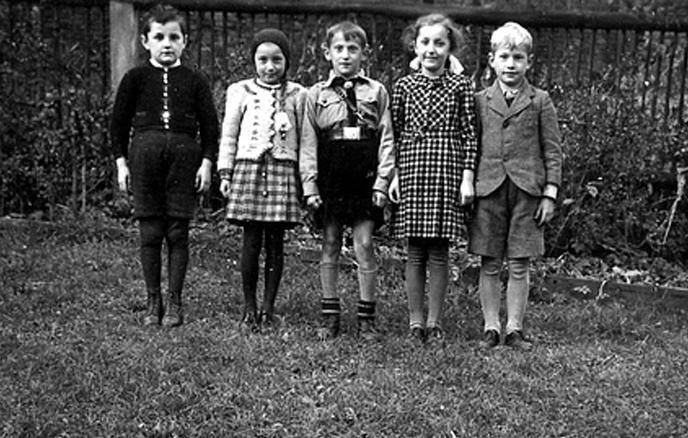
Sudetenland Population

Figure 1.-- Konrad Henlein, head of the Sudeten German Party (SdP), helped to politicize the Sudeten Germans who by 1938 were strongly pro-NAZI. Most Sudeten Germans welcomed the German annexation as result of the Munich Conference (September 1938). Here we see a group of Sudten German children in 1938, we think in October shortly after the NAZI take over. The unidentified children look to be about 7-8 years old. They lived in Königsberg an der Eger. Notice that one boy eager to join the Hitler Youth has aklready acquired a uniform. The photograph looks to have been taken in one of the children's back yard, probably the boy wearing the HJ uniform. The other children all wear long stockings with Leibchen obviously. The boy at the extreme right is very dressed up in a short trousers suit, with shirt and necktie and (I think) a sleevless sweater. The tan long stockings were very fashionable in the 1930s.
|
|
The Sudeten Germans have for centuries lived in the area. The term "Sudeten Germans"
has been used in the 20th century to designate the German population in the three provinces known in the Austro-Hungarian Empire as the lands of the Bohemian Crown. The Sudeten Germans are ethnically related to the major German tribes and are ethnically indistinguishable from Bavarians, Franconians, Saxons and Silesians. The population of the Sudetenland included about 3.5 million German speakers. Until 1919 they were governed by German-speaking Hapsburg rulers in Vienna. The peace conference at St. Germain in 1919, however, left them as part of the new independent Czechoslovakia. (The better known Versailles Peace Conference ended World War I with Germany. The St. Germain Peace Confernce ended the War with Austro-Hungary.) The Sudete Germans found themselves a minority within Czecheslovakia. HBC believes that they continued to have German-lamguage schools, but as a minority many government jobs requiring a command of the Czech language were difficult to obtain. The incidents of physical attacks and rapes claimed by the NAZIs, were largely the product of the ferile mind of Reich Minister of Propoganda, Josef Goebels. Many Czechs were expelled. After the War, the Soviets liberated Pague. Units of the American 3rd Army reached western Czecheslovakia. Reprisals aginst Germans began with the arrival of the Red Army. Individuals and groups sought vengence by attacking ethnic Germans. Many wanted their property back that the NAZIs had seized. When President Benes returned from London he issued official decrees which began the expulsion of 2.5 million Sudeten Germans. Hungary had been a German ally and te Czeches also expelled 0.5 million ethnic Hungarians. The population of Czecheslovakia thus became largely Czech and Slovak.
HBC

Navigate the Boys' Historical Clothing German pages:
[Return to the Main Sudetenland page]
[Return to the Main German regional page]
[Return to the Main Czecheslovakian page]
[German choirs]
[German movies]
[German school uniforms]
[German royalty]
[German youth groups]
[German sailor suits]
[Lederhosen]
[Ethnic]
[Tights]
[Long stockings]
Navigate the Boys' Historical Clothing Web Site:
[Introduction]
[Activities]
[Biographies]
[Chronology]
[Clothing styles]
[Countries]
[Bibliographies]
[Contributions]
[FAQs]
[German glossaries]
[Images]
[Links]
[Registration]
[Tools]
[Boys' Clothing Home]
Created: 11:51 PM 6/22/2011
Last updated: 11:51 PM 6/22/2011



